For months now, we’ve heard from a variety of sources that the Trump administration is readying a proposal which would roll back 2025 vehicle standards to 2020 levels, halting progress on reductions in emissions and oil use at the same time that transportation has become the largest source of global warming emissions in the U.S. With Scott Pruitt resigning from his post at the EPA, many had high hopes that this could signal a change in direction for the agency—unfortunately, Acting Administrator Andrew Wheeler appears headed down the same wrong-headed path.
With the standards on the cusp of being rolled back, I thought it would be helpful to put into context exactly what is at stake. The technology is here to move industry and the country forward while providing consumers with tremendous savings, increasing jobs and economic growth, improving national security, and reducing environmental impacts of the largest source of global warming emissions in the country—Acting Administrator Wheeler should be siding with the science to protect those gains, and moving us forward towards even stronger standards beyond 2025.

The current fuel economy and global warming emissions standards have helped “bend the curve” on emissions from cars and trucks, but they are not sufficient to hit our climate goals. The current administration’s push to roll back these rules is a huge step backwards precisely when we should be moving forward on even stronger standards.
Rolling back vehicle standards: by the numbers
We cranked the numbers on what this rollback would mean, together with their threat to void state regulations on vehicle emissions, and it is truly staggering:
- Rolling back these standards will result in an additional 2.2 billion metric tons of global warming emissions by 2040—that’s 170 million metric tons in 2040 alone, equivalent to keeping 43 coal-fired power plants online.
- These inefficient cars and trucks will use an additional 200 billion gallons of gasoline by 2040—that’s as much oil as we’ve imported from the Persian Gulf since the standards were first finalized in 2010.
- This will cost consumers hundreds of billions of dollars—in 2040 alone, consumers will spend an additional $55 billion at the pump if these standards are rolled back.
And it’s even worse than that!
There are, of course, additional impacts that we have not yet directly quantified. For example, automotive suppliers provide about two-thirds of the value of a new vehicle, and they’ve invested in the long-term to reduce fuel use—rolling back these standards will mean reduced returns on that investment, likely prompting some of these global companies to move their R&D facilities to the countries still charting a course forward, like China and the European Union. Combined with consumers’ reduced discretionary spending, which means less money in job-intensive sectors like the service industry and retail, this action will result in job losses and shrinking economic growth. The current 2017-2025 standards are slated to create more than 250,000 jobs nationwide by 2035 and increase GDP by $16 billion—President Trump’s action could cut that growth in half.
By going after state authority to set emissions standards, the administration would also be fighting against one of the strongest levers California and other states have on public health. Electrification of transportation is a key component of many state plans to meet air quality requirements. Attacking state leadership on cleaner vehicles is a direct attack on public health, particularly that of the most vulnerable communities.
The only clear winners of this rollback would be the oil companies—with consumers forking over more of their hard-earned money for every fill-up.

